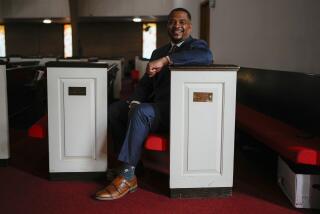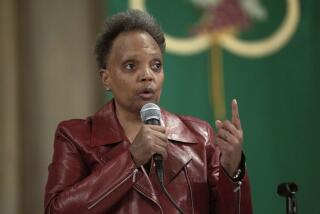Chicago -- the wimpy city
I FONDLY REMEMBER visiting the Sears Tower in Chicago almost 20 years ago. Before being allowed to enjoy the view from what was then the world’s tallest building, visitors had to sit through a promotional film about how rough and tough and great and booming the Second City was. (Never mind that the proud hometown of baseball’s sad-sack Cubs had already slipped to third place in population, behind Los Angeles.)
At some point in the film, the narrator -- possessed of a tooth-rattling basso profundo usually reserved for more elevated art forms, such as NFL highlight reels -- proclaimed, apropos of nothing, that “Chicago ain’t no sissy town!” He was, if memory serves, quoting an alderman or some other species of criminal native to the Windy City.
But it turns out that Chicago is a sissy town because that “stormy, husky, brawling ... City of the Big Shoulders,” in Carl Sandburg’s evocative 1916 poem, seems hellbent on putting a chokehold on just about everything that makes a city a city. Namely, fun. Local pols evidently are more dedicated to rooting out gluttony among residents than reining in a police department neck deep in an ugly torture scandal.
Over the last year, the Associated Press recently reported, Chicago snuffed out smoking “in nearly all public places” and pulled the plug on using cellphones while driving. This April, the “Hog Butcher for the World” (Sandburg again) became the first city in the country to ban the sale of foie gras, on grounds that force-feeding geese to make the tasty treat is more cruelty than Al Capone’s adopted hometown can bear.
In July, the City Council held hearings on banishing trans fats from Chicago’s fast-food chains, as if such a move could do much to clear arteries in the birthplace of the deep-dish pizza (Men’s Fitness magazine has declared Chitown the fattest city in the U.S.). There was also talk of forcing dog owners to implant identifying microchips in pooches (though not pit bulls, because if the council got its way, the breed would be no more welcome in Chicago than Mrs. O’Leary’s cow). Council members, the Chicago Tribune has noted, “have threatened to use their legislative might to improve living standards for elephants ... require taxi drivers to wear crisp white shirts and matching pants and socks ... [and] require cigarette vendors to display photos of diseased lungs prominently.”
More recently, the council passed a “living wage” ordinance requiring big-box retailers such as Wal-Mart and Target to pay a minimum of $10 an hour plus benefits by 2010 or face draconian penalties (perhaps a deep-dish plate of a kinder, gentler foie gras, or repeated showings of that old Sears Tower promotional film?).
“Come and show me another city ... so proud to be alive and coarse and strong and cunning,” Sandburg wrote 90 years ago. What a difference a near-century makes.
Sure, the White Sox, a baseball franchise rivaled only by the Cubs for long-term ineptitude, won the World Series last year, and may yet make the playoffs this year. But even if the team miraculously repeated, how could Chicagoans legally celebrate? By not talking on their cellphones while driving? By eating soy pate? By paying Wal-Mart greeters a living wage -- if you can still call residing in a city of dead pleasures living?
The worst part about Chicago’s clampdown on seemingly every urban excess is that it’s not even original. One need look only to America’s two biggest cities, New York and Los Angeles, to see similar buzz-killing rules firmly in place, with more in the pipeline.
In years gone by, people poured into cities to escape the conformity and monotony of life on the farm or in the small town. Now they go there to frown at aberrant behavior and pick up after their dog. In this, alas, Chicago is truly America’s third city -- and sadly, not the last.
More to Read
Sign up for The Wild
We’ll help you find the best places to hike, bike and run, as well as the perfect silent spots for meditation and yoga.
You may occasionally receive promotional content from the Los Angeles Times.






